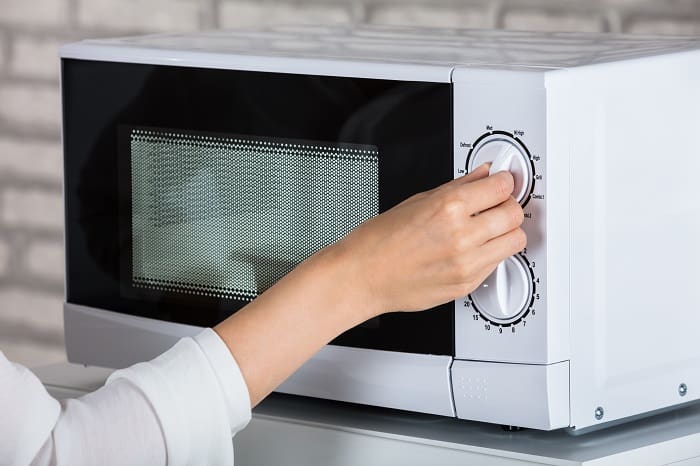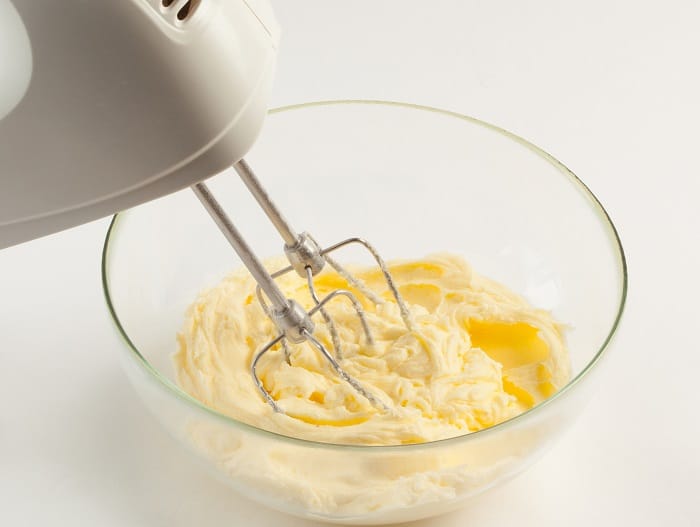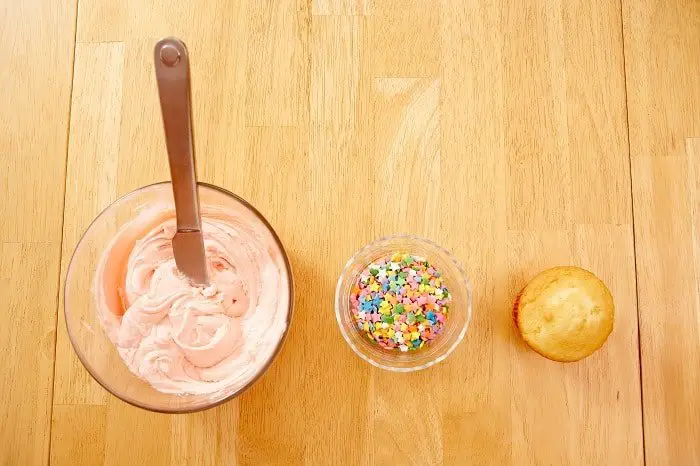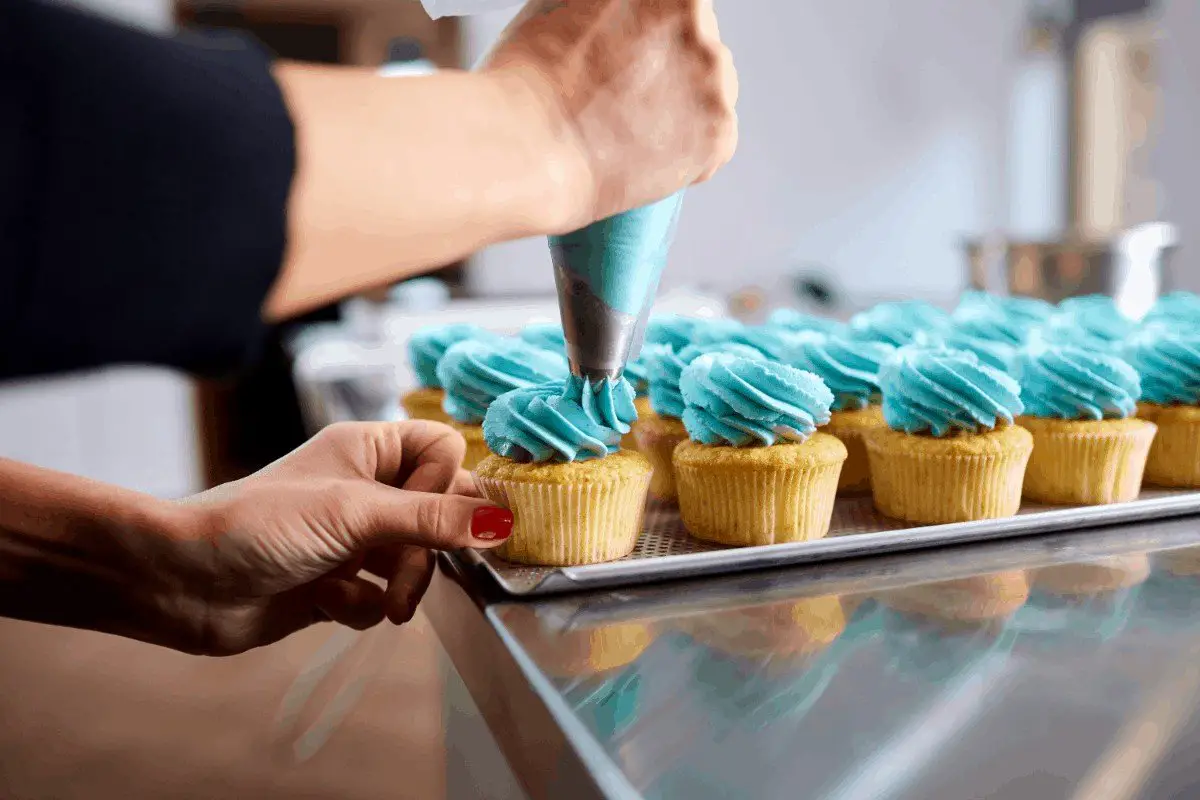Last Updated on March 17, 2023
There are several methods for how to softening refrigerated buttercream frosting. Most people will store their leftover buttercream in their fridges to ensure freshness and quality. However, buttercream frosting is best served at room temperature.
If you have unused buttercream or frosted baked goods that have been sitting out for more than three days, you will want to keep them in your fridge. Storing buttercream in your fridge allows it to have a longer shelf life. If left out too long, the buttercream will become stiff, begin to separate, and may be prone to causing foodborne illnesses.
How to Soften Refrigerated Buttercream Frosting: The Process
If you have your buttercream in the fridge, you will want to let it soften before using it to decorate. You will learn different ways how to soften refrigerated buttercream frosting, depending on what is most convenient for your needs.
Microwave Method
If you are in a rush and are looking for a quick way to soften your buttercream, you can use a microwave. If you use a microwave, you need to be careful not to heat it for too long. The buttercream will melt if it gets too hot.
To soften your buttercream in the microwave, use a low power setting and don’t microwave it for more than fifteen seconds at a time, depending on the amount of buttercream you have. You will want to microwave the buttercream in intervals, to make sure it doesn’t melt. You should stir the buttercream every time to make sure the heat will evenly disperse in the frosting.

If you have a large amount of buttercream, you can microwave small portions and mix them into the rest of your buttercream. Mixing the small amount of microwaved buttercream into the rest of your buttercream will allow heat to transfer and soften it. This is a good method if you have a lot of frosting you are trying to soften.
This is one of the easiest ways to soften your buttercream with the best results. This helpful YouTube tutorial demonstrates how to use a microwave and stand mixer to soften your buttercream.
Rest at Room Temperature
If you are not in a hurry, you can set out your buttercream frosting in your kitchen at room temperature. You can let the frosting rest for thirty to forty-five minutes. This allows the frosting to gradually reach the right temperature without the worry of it melting.
After the frosting has reached room temperature, you can use a small stand mixer or a good wooden spoon to mix it. Sometimes buttercreams separate after a few days, so they need to be mixed back together to reach the right consistency.
Add Corn Syrup
A quick way to soften your buttercream is to add some clear corn syrup. This will help loosen your buttercream if it has become stiff. Add just a few drops at a time and mix until the buttercream has achieved a desirable texture.
Water Bath
Another efficient way to soften your buttercream is with a warm water bath. Simply place the buttercream in a metal bowl above a pot of either boiling or warm water. Leave the bowl of frosting above the water until it has reached room temperature, stirring occasionally to make sure the frosting is evenly heated.
Whisk Frosting
You may also soften your buttercream frosting using a stand mixer with a whisk attachment. Allow your buttercream to sit out for a few minutes and then turn your mixer on medium speed and beat the frosting for a couple of minutes. Use a spatula to scrape the sides of the bowl and if needed beat the frosting for longer.

Using Your Hands
If you have a small amount of buttercream you are trying to soften you can put it into a piping bag and use the warmth from your hands to soften it. Squeeze the bag of frosting with your hands until you feel it has reached your desired consistency.
Homemade Versus Store Bought Buttercream Frosting
If you have homemade buttercream frosting, it will generally last in the fridge for up to two weeks. Homemade buttercream is also more likely to separate, so no matter what method you use to soften it, you will have to mix it for it to return to the right consistency.
Store-bought buttercream frosting has a longer shelf life and can last in the fridge for up to three weeks after opening. It also does not separate like homemade buttercream does and it often softens more quicker.
If you don’t have the time to make the frosting, you can purchase some tasty buttercream frostings at your local grocery store or on Amazon. Duncan Hines and Pillsbury have some delicious buttercream frostings that will go great with your baked goods.
Why To Soften Buttercream Frosting
Buttercream frosting should be at room temperature when you are decorating your baked goods. This will allow it to be at the proper consistency and allow shapes to hold their form. Since buttercream has a high-fat content, it sometimes has an oily consistency when it is cold.

When the buttercream is cold, it has a very firm texture, unlike the creamy consistency it has at room temperature. The firm texture it has when it’s cold makes it difficult to frost with, especially if you are trying to pipe decorations.
Buttercream frosting can be tricky to work with sometimes. That’s why serving it at room temperature will allow it to be at its best texture. Buttercream frosting starts to separate if it is too cold or too warm. However, it is important to store it in the fridge to help it stay fresh and keep its quality.
How Do You Frost a Smooth Buttercream Cake?
There’s nothing more satisfying than a completely smooth buttercream cake. However, getting it smooth can prove somewhat difficult. But don’t worry! We have an easy guide to ensure you get your cake just right. Once your cake has been chilled and stacked, just follow these simple steps:
Step 1: Crumb
Once stacked, cover the entire cake with a thin layer of frosting. This is called crumbing the cake and makes the second layer of frosting much easier. Use a large spatula to spread the frosting around the entire cake, including the sides.
Smooth the frosting with a bench scraper and remove any excess buttercream from the scraper as you go. This layer of frosting doesn’t need to be perfect, but try to make it as smooth as possible. Once finished, chill your cake for around 20 minutes in the refrigerator (or 5 minutes in the freezer, if you’d prefer).
Step 2: Frosting Layer #2
Stir your buttercream before you start working on the next layer of frosting. I’ve found a few minutes with a rubber spatula is enough to get it back to the smooth consistency we’re looking for. Using a spatula, apply another layer of buttercream on the top and sides of your cake.
This layer should be much thicker than the previous layer and should now have hidden the cake. Again, smooth the frosting with your bench scraper. Applying pressure and removing any excess buttercream is even more important at this point.
Step 3: Fill Any Gaps
If there are any gaps with little to no buttercream, simply add a small amount and smooth with your bench scraper. Repeat this until all gaps and spaces are filled.
Step 4: Heat
Now place the scraper under hot water. Dry it and carefully begin to smooth the frosting again. The slowly, the better. This helps to give your cake a silky finished look. Remember to use a spatula to remove any excess as you go to ensure your cake looks clean and smooth at the end. Your smooth buttercream-covered cake is ready!
How Long to Thaw Buttercream From Fridge?
If your buttercream has been stored in the refrigerator, all you need to do is remove the buttercream from the fridge and leave it on the counter until it reaches room temperature. If your buttercream has been frozen, it’s best to leave it to thaw in the fridge overnight and then take it out to come to room temperature on the counter. Regardless of whether it’s been chilled or frozen, you’ll need to re-whip your buttercream again. This will help your buttercream go back to the silky, smooth consistency it once was.
Why Do You Have to Refrigerate Frosting After Opening?
Most frosting requires refrigeration once opened. This can be for a variety of reasons. One of the main reasons is that frosting often contains milk and/or butter.
When these products are not refrigerated, they tend to spoil much quicker and become more susceptible to problems such as growing mold. Another reason is that frosting melts fairly quickly. If left in the refrigerator, your frosting will stay fresher for longer, which is exactly what you want. Most frosting will last at least two weeks in the refrigerator once opened.
How Long For Buttercream to Harden in Fridge?
If you’re looking for your buttercream to be firmer or harden, it’s best to pop it into the fridge. Most buttercream will harden in the fridge within 15-30 minutes.
How Long Does Buttercream Last Out of the Fridge?
The answer to this is: it depends on what your buttercream is made from. Generally speaking, buttercream can last around 2 days at room temperature. But even then, it should be covered in plastic wrap to ensure the buttercream stays as fresh as possible. If you’re unsure about your specific buttercream or frosting, be sure to check the directions label on the tub as it’s usually super helpful.
Can You Eat Frosting That Wasn’t Refrigerated?
It all depends on the type of frosting and how long the frosting has been sitting out. If it’s just been a few hours, almost all frosting will still be okay. Most buttercream made with shortening or butter will be fine at room temperature for up to two days. If whipping cream has been used, it’s best to only eat that at room temperature if it’s been a few hours.
Do You Have to Refrigerate Duncan Hines Frosting?
Duncan Hines state that as long as their frosting is unopened, it can be stored at room temperature. However, once opened it must be covered and stored in the refrigerator. This way it will remain reusable for up to 30 days.
Choosing the Simple Method That is Ideal for You
Softening your buttercream is important before using it. Luckily, there are many simple ways to do it that will make your buttercream creamy again.
If you tried any of these methods for softening buttercream frosting, please share your experience making it.
Please comment if you enjoyed this article or have any remarks regarding this article!
Here’s a quick review of the methods you can use to soften buttercream:
- Microwave
- Rest at room temperature
- Add corn syrup
- Water bath
- Whisk frosting
- Use your hands

Karen is a passionate pastry chef who loves to create delicious baked goods. She has been in the culinary arts for over 10 years, honing her skills and perfecting her craft. Karen is known for her creativity and attention to detail, creating unique desserts that bring a smile to everyone’s face. She is always looking for ways to challenge herself and come up with new recipes that are both tasty and visually appealing. Karen loves to experiment with different flavors and textures, and she is committed to providing the highest quality of products to her customers.




